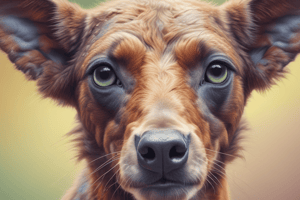Podcast
Questions and Answers
What is the inheritance pattern observed in individuals with AB blood alleles in the ABO blood system?
What is the inheritance pattern observed in individuals with AB blood alleles in the ABO blood system?
- Incomplete dominance
- Sex-linked inheritance
- Co-dominance (correct)
- Polygenic inheritance
In snapdragons, what is the result of crosses between red (RR) and white (WW) plants due to incomplete dominance?
In snapdragons, what is the result of crosses between red (RR) and white (WW) plants due to incomplete dominance?
- Pink plants (correct)
- Purple plants
- Red plants only
- White plants only
Which of the following is an example of sex-linked inheritance?
Which of the following is an example of sex-linked inheritance?
- Flower color in snapdragons
- Human height
- Colorblindness (correct)
- ABO blood group system
How does polygenic inheritance differ from simple inheritance patterns?
How does polygenic inheritance differ from simple inheritance patterns?
What is the result when pink snapdragons are crossed?
What is the result when pink snapdragons are crossed?
Which inheritance pattern involves the expression of both A and B antigens equally in individuals with AB blood?
Which inheritance pattern involves the expression of both A and B antigens equally in individuals with AB blood?
In the context of genetics, what does a recessive gene require to express its trait?
In the context of genetics, what does a recessive gene require to express its trait?
Which genetic disorder requires an individual to inherit two copies of a recessive allele to be expressed?
Which genetic disorder requires an individual to inherit two copies of a recessive allele to be expressed?
What type of genetic expression results in traits displayed in a blended form?
What type of genetic expression results in traits displayed in a blended form?
Which genetic system involves the IA, IB, and i blood alleles?
Which genetic system involves the IA, IB, and i blood alleles?
If an individual has type A blood, what is the genotype of their blood alleles?
If an individual has type A blood, what is the genotype of their blood alleles?
What characteristic distinguishes a dominant gene from a recessive gene?
What characteristic distinguishes a dominant gene from a recessive gene?
Flashcards are hidden until you start studying
Study Notes
Heredity and Variations: Uncovering Inheritance Patterns
Heredity, the transfer of genetic information from one generation to the next, is a fundamental process that shapes the traits we observe in living organisms. Variations, or differences in these traits, can arise due to changes in an organism's genetic makeup. Understanding inheritance patterns is crucial for deciphering how these variations are passed down from parents to offspring.
Dominant and Recessive Genes
Inheritance patterns are often described through the lens of dominant and recessive genes. A dominant gene will express its trait in an organism, even if it is present in only one allele (a version of a gene). Arguably the most famous example of this is the human ABO blood system, where individuals with the IA, IB, or i blood alleles will produce type A, type B, or type O blood, respectively, due to the dominance of the I allele over the i allele.
Conversely, recessive genes will only express their trait when both alleles are recessive. For example, sickle cell anemia is caused by the recessive allele HbS, which causes red blood cells to become misshapen due to abnormal hemoglobin. An individual must inherit two copies of the HbS allele to have sickle cell anemia.
Co-dominance
Some genes exhibit co-dominance, where the traits expressed by both alleles are displayed, often in a blended form. The human ABO blood system also demonstrates co-dominance, as individuals with the AB blood alleles will produce both type A and type B blood. This is because the IA and IB alleles are co-dominant, expressing both A and B antigens equally.
Incomplete Dominance
Another inheritance pattern is incomplete dominance, where the expression of the dominant allele is weaker than the recessive allele. This phenomenon is observed in flower color in snapdragons, where the red (R) allele is incomplete dominant to the white (W) allele. Crosses between red and white plants produce pink plants, but pink plants will produce red and white offspring in a 1:1 ratio.
Sex-linked inheritance
In some species, genes are located on sex chromosomes, leading to sex-linked inheritance. Due to the difference in the number of sex chromosomes between males and females, sex-linked inheritance can affect the expression of certain traits in males and females differently.
For example, colorblindness is a sex-linked recessive genetic disorder caused by a mutation in the X chromosome gene. Females must inherit two copies of the mutated gene to be colorblind, while males only need one copy.
Polygenic inheritance
Many traits are influenced by multiple genes, leading to polygenic inheritance. For instance, human height is a polygenic trait, with many genes contributing to the variation in height among individuals. The study of polygenic inheritance is more complex than simple inheritance patterns, involving the analysis of large populations and advanced statistical methods.
Conclusion
Understanding inheritance patterns is essential for comprehending the genetic basis of traits and variations among living organisms. By studying the dominant, recessive, co-dominant, incomplete dominant, sex-linked, and polygenic inheritance patterns, we can better understand the genetic makeup of organisms and the factors that shape their physical and behavioral characteristics.
Studying That Suits You
Use AI to generate personalized quizzes and flashcards to suit your learning preferences.



